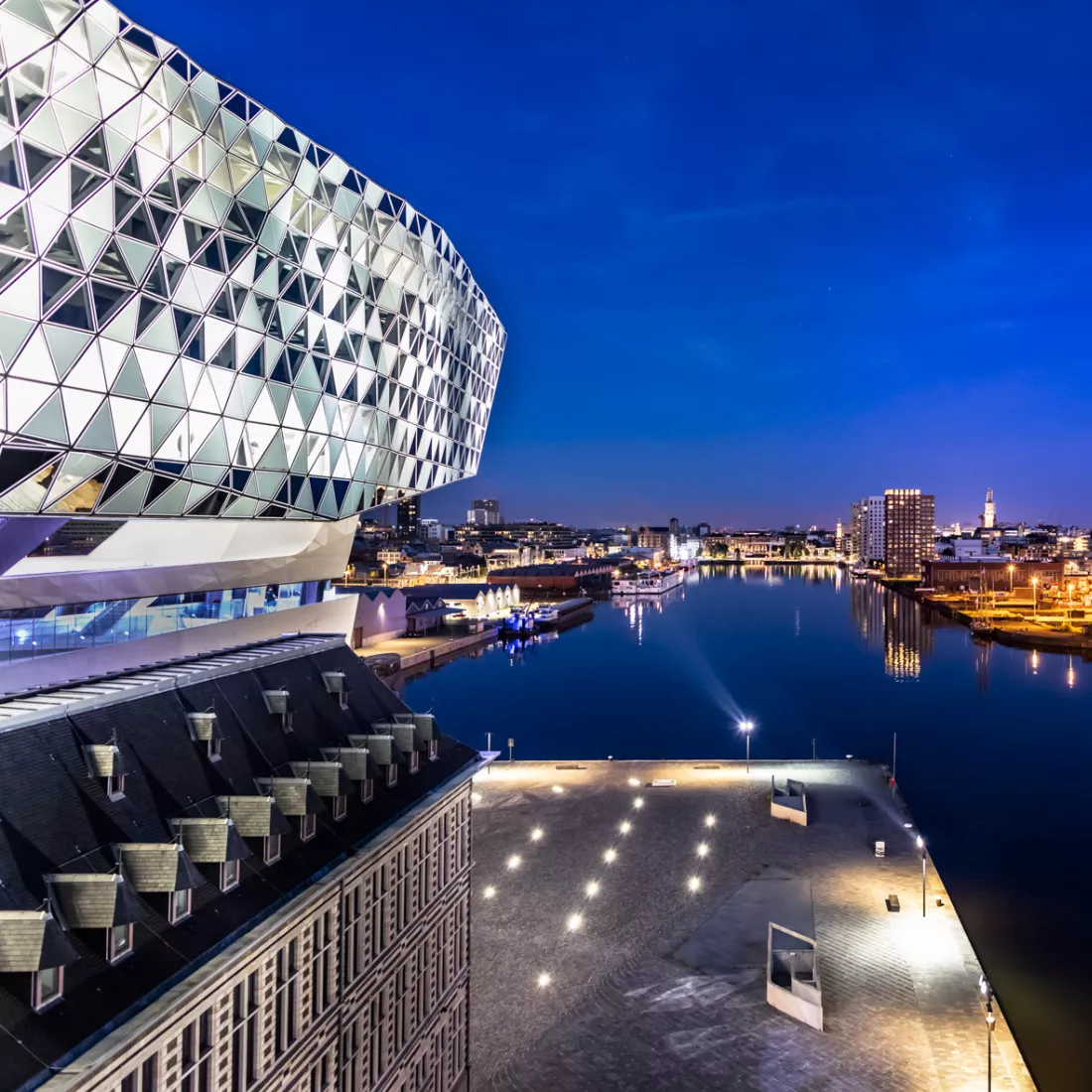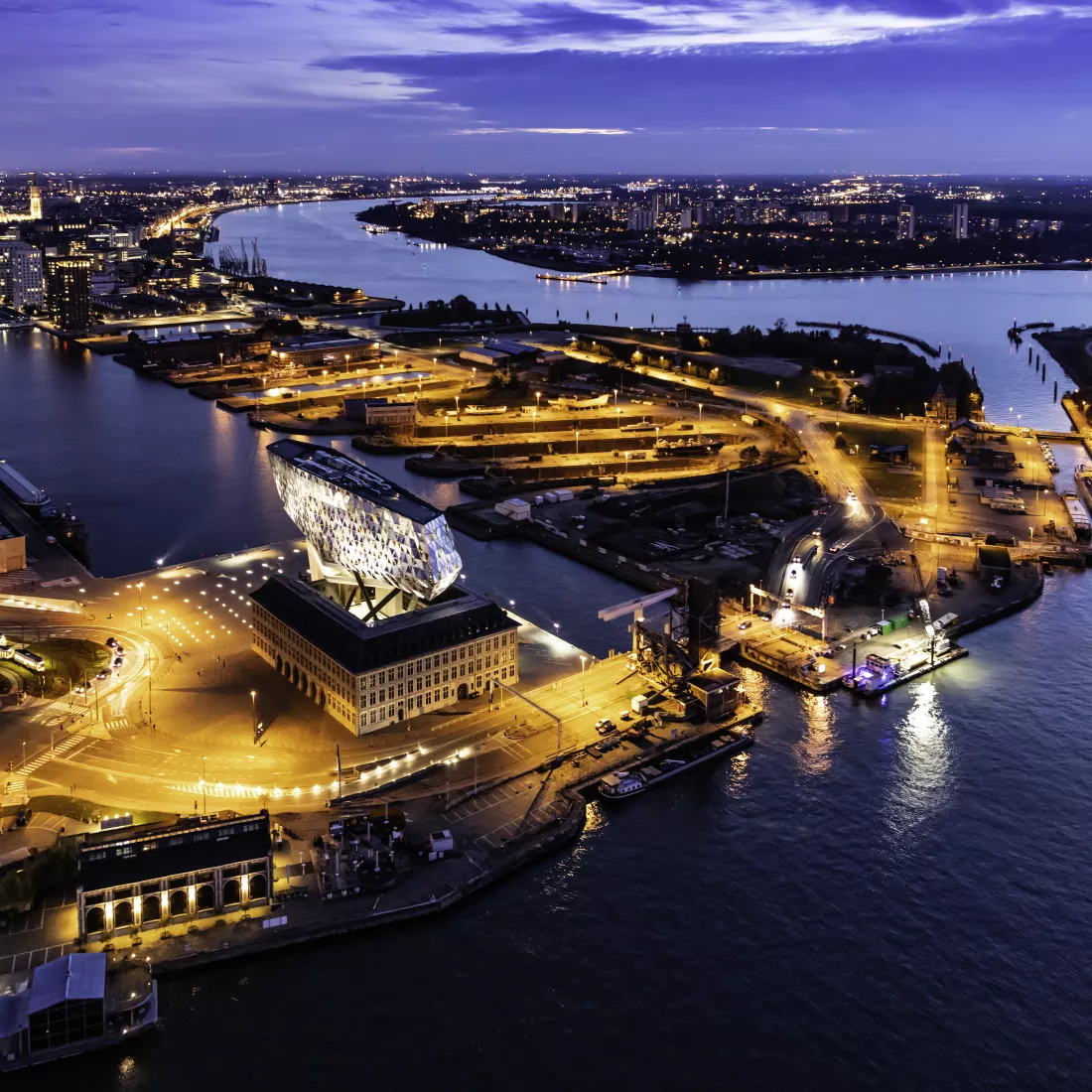
- Home
- Why invest
- Antwerp: strategically located in Europe
Antwerp: strategically located in Europe
Your ideal gateway to Europe – and beyond
Did you know Antwerp is located in the northern part of Belgium, in a region called Flanders? Are you aware that our city has unparalleled connectivity thanks to its inland location 80 km from the coast? This is why Antwerp is your ideal European gateway, close to all major European and international industrial and consumer markets.
Our city and port offer you the fastest, most cost-effective, suitable connections to the European hinterland. Over 60% of European purchasing power is situated within a radius of 500 kilometres of Antwerp. Antwerp is the departure point for the shortest route to European customers and industry.
Our port is actually a unified port - a unique collaboration between two individual ports. The Port of Antwerp-Bruges is the second largest container terminal in the world. Together, we cater for the largest vessels, in Antwerp, up to eighty kilometres inland – bringing products as close as possible to their final destination. Where ships are offloaded, a modern network of railway lines, roads, pipelines and waterways carries goods to the heart of Europe in no time.
Antwerp also boasts a top spot in digital connectivity rankings. We have been one of the top ten areas with the best broadband access for several years now. Mobile coverage is equally reliable. Combined with a wide range of modern communication and tracking tools, this means you are always as close as possible to your goods – even if they are physically thousands of kilometres away. Ready to start exploring?
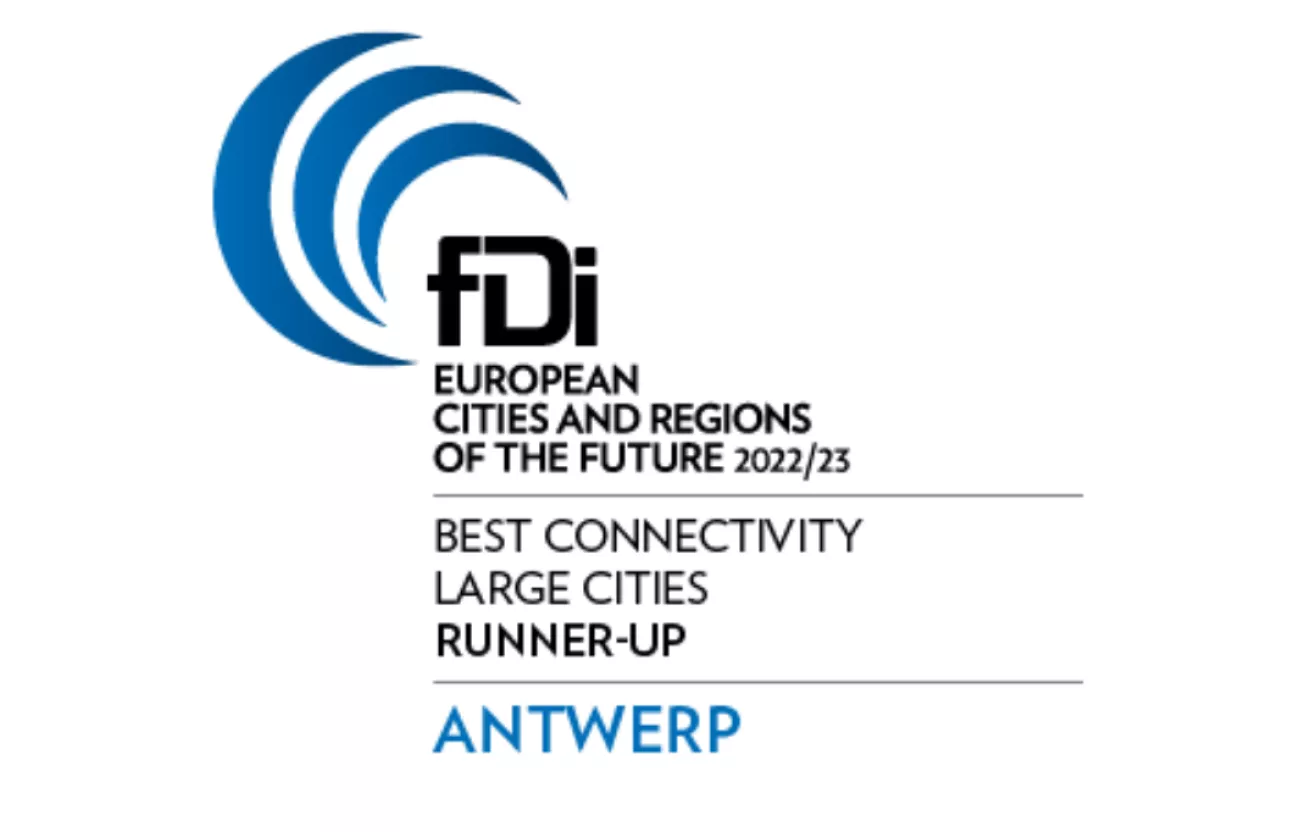
Antwerp's central location in Europe allows you to connect your business to the world. FDi Intelligence, a specialist division of the Financial Times, has ranked Antwerp in the top 10 for connectivity, indicating Antwerp’s high level of international interconnectivity for companies located in the city.
Goods & Services
Accessible and mobile at a lower cost
The Port of Antwerp-Bruges truly is a world port. It is the largest European port for conventional cargo and the 2nd largest port in Europe. This makes our port a major gateway to Europe, with excellent infrastructure for receiving all types of transport and goods. What’s more, there is no other port so centrally located in Europe. It makes transporting your goods to consumers – regardless of the method used - easier, more sustainable, more efficient and therefore less expensive.

Imagine the wooden vessels of booming 16th century Antwerp passing by on the River Scheldt. Well, maritime transport is still the basis of the Port of Antwerp-Bruges’ success. Via the Scheldt river, seas and oceans, sea-going ships can navigate between Antwerp and the remotest corners of the world. Ever-larger sea-going ships bring goods to Antwerp, but also take products on board before departing for their next distant destination. No port is more centrally located in Europe than Antwerp. Ships bring their goods very close to customers – your customers. Start planning your journey with our unique navigation tool.
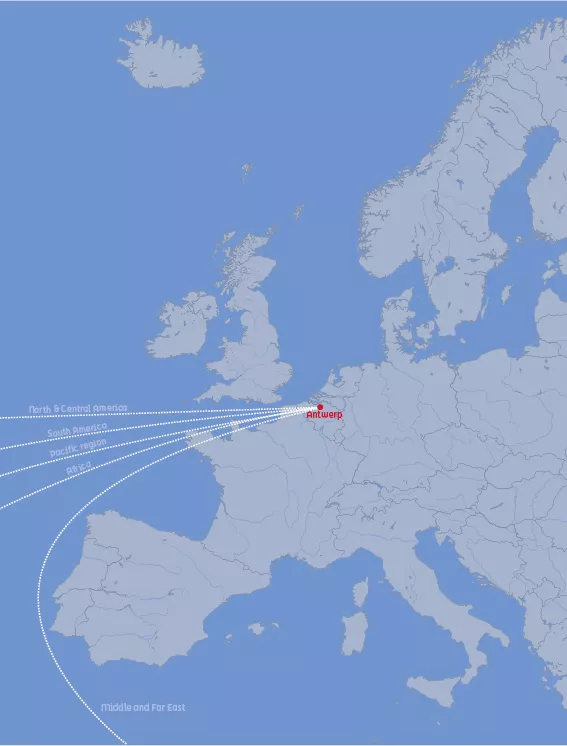

In Antwerp, the sea extends inland, creating incredible opportunities for heavy goods waterway transport. The port of Antwerp-Bruges is connected to the river Scheldt and offers seamless transportation of goods via waterways such as the Albert Canal, the Scheldt-Rhine Connection, and the Scheldt-Seine Connection. Inland navigation vessels can transport massive quantities of goods at once, allowing for speedy and efficient transport of all kinds of products. 48% of goods from the port are transported via inland shipping. In fact, even the goods found in the famous Belgian Colruyt megastores are transported to a central warehouse in Brussels via inland navigation vessels! What's more, this network of rivers and canals can take your goods to destinations well beyond Belgium, reaching countries such as the Netherlands, Germany, Austria, Switzerland, and France. Plus, with top-notch connections to the extensive European barge network, the port of Antwerp-Bruges offers short transit times to strategic areas in the European hinterland.
An intelligent route planner is also available for your transportation by ship.
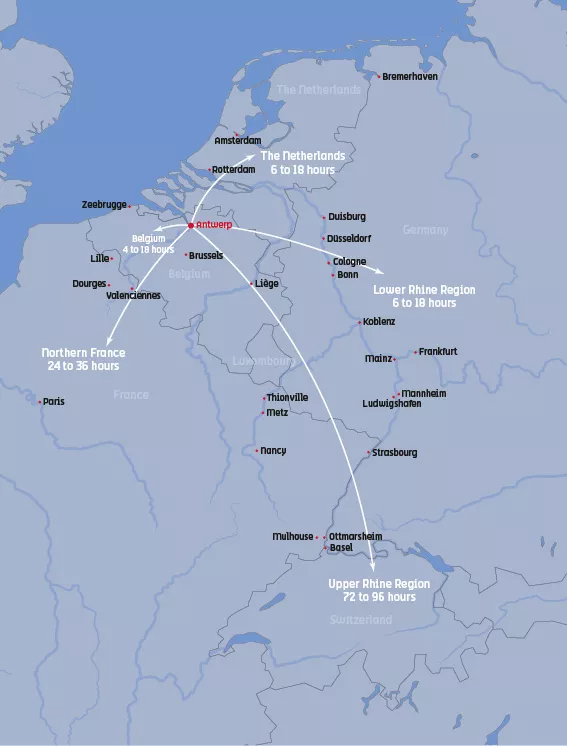

One of the most impressive features of Antwerp is its position right in the heart of a massive rail network that spans across Europe. This network can take you to destinations as far away as Spain, Norway, Greece, and Poland, with a whopping 70 destinations served in 19 countries each week. And the best part is that all terminals in the port of Antwerp are linked to this network, ensuring efficient effective transportation of your freight. Whether you need to move containers or bulk goods like coal, sand, or chemicals, Antwerp's rail network has got you covered.

Many millions of tonnes are transported to and from Antwerp each year. Just think of petroleum, fuel oil, petrol and natural gas. The Port of Antwerp-Bruges is one of Western Europe’s most important pipeline hubs. Pipelines offer the industry a safe, reliable and environmentally-friendly means of transportation for the supply and distribution of liquid products. Thanks to its pipeline network, the port has connections to other industries in Belgium, Germany and the Netherlands.
The best-known pipeline to the Antwerp port area is the Rotterdam Antwerp Pipeline. Each year, 30 million tonnes of petroleum flows from Rotterdam to Antwerp through this 102-kilometre-long pipe. Without this pipeline, 1,100 large tanker trucks would have to drive back and forth, day and night, between the two cities in order to transport the same amount of oil. Kerosene - fuel for airplanes - is also transported from Antwerp to Zaventem in this way.
Our pipelines are playing a crucial role in the upcoming energy transition. 1,000 kilometres of pipeline carrying more than 48 different types of products, including hydrogen, provide an essential framework accounting for almost 90% of all liquid goods transported within the port. Our port is set to play a vital role in the local and international green hydrogen supply chain. Pipelines are also vital for the creation of heat networks. The ECLUSE steam network supplies energy to surrounding port companies using heat from six combustion plants.

Antwerp is a major transport hub and is surrounded by large, modern and safe motorways. Our highway network leads directly to neighbouring countries and onward to more distant destinations. Loads that fit in a single container or truck can be transported very quickly by road to their next destination. Moreover, such road transport is necessary whenever a destination cannot be reached by inland navigation vessel or freight train. Antwerp’s location 80 kilometres inland means that the road transport distances to the heart of Europe can be significantly shorter than you might think. The Big Link, one of the largest infrastructure projects in Europe, will complete the Antwerp ring road, thereby ensuring that its port and logistics network will remain an engine for the Flemish and European economy.
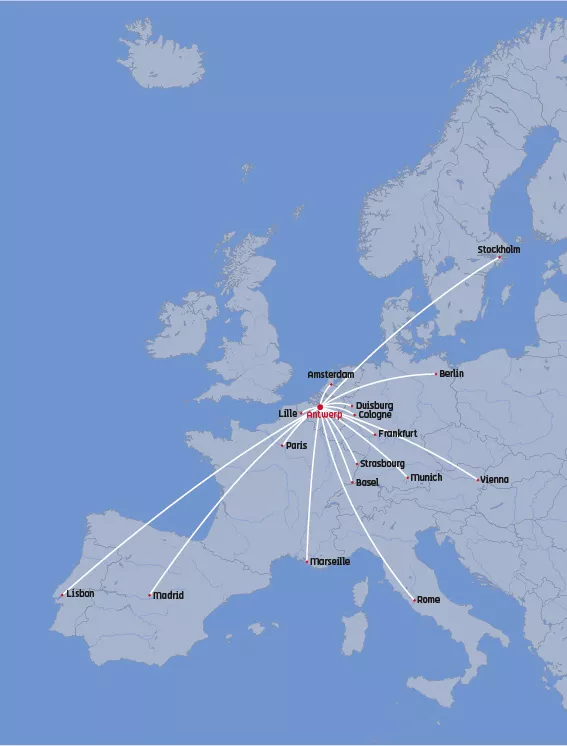

Europe’s ten largest airports are all easily accessible from Antwerp Airport. Antwerp has its own flexible airport in an excellent location close to the city centre with short check-in times. Brussels Airport, Belgium’s largest international airport, is also less than 35 minutes away. Liège Airport, a major cargo hub, is less than an hour away by road. Travel time to London, Paris, Frankfurt and Hamburg is just one hour. Information about air connections from Antwerp Airport to other interesting business destinations in Europe can be found here.
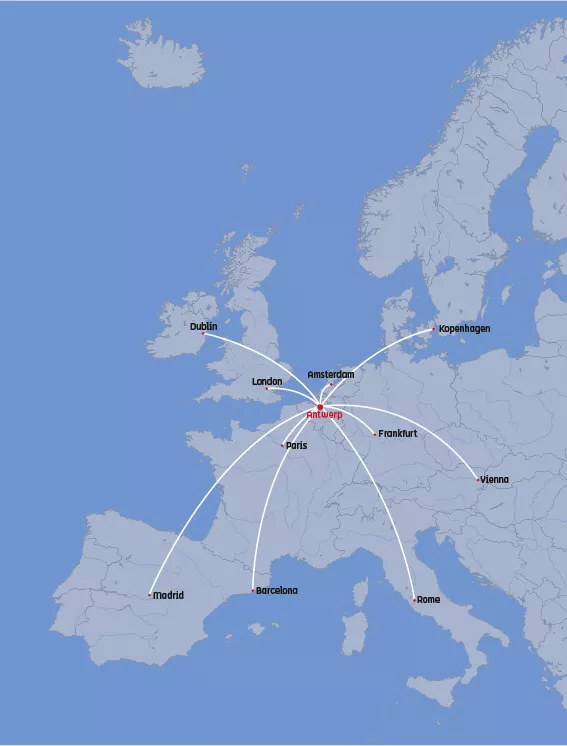
Mobility to and within the city
Accessibility and mobility
Antwerp has excellent connections to surrounding business centres, such as London and Paris, via motorway, high-speed train and airplane. Within the city, a number of mobility projects usually guarantee hassle-free movement in and around the metropolis.

Antwerp is well connected with an extensive road network. Several regional motorways enable easy circulation while the city also lies at the crossroads of five major international motorways. Road traffic in Antwerp will flow even more smoothly in the future with the construction of The Big Link ring road, one of the largest infrastructure projects in Europe. The Big Link aims to achieve a 50/50 modal shift through investments in road and cycling infrastructure, new tram lines, extensions to the suburban train network, and the creation of green, extensive parks on top of the Antwerp ring road. An improved link will also be constructed between the E313/E34 from Hasselt and Eindhoven with the E19. The A102 is to become a tunnel in the direction of Breda.

Antwerp’s Central Station - one of the world’s most beautiful train station buildings - is located right in the city centre. Thanks to Antwerp’s high-speed train connection, major cities in France, the Netherlands, Germany and England are within easy reach from the city centre, with minimal travel times: Paris is only two hours away. The HST trains also offer fast connections to Europe’s major international airports.

In a highly-developed region, where one city is just a stone's throw away from another, the city of Antwerp combines the best of all worlds. Home to the busy Port of Antwerp-Bruges and its international trade opportunities, Antwerp is the cultural capital of Flanders. It is also very close to Brussels, the capital and beating heart of the European Union (EU), with 25,000 lobbyists and 1,300 international headquarters, and to NATO and the world’s second most important location for global media. The European Customs Union is a unified market: the market conditions in all 27 member states are identical, with free movement of goods, people and capital throughout the EU. All goods go through import/export procedures only once, after which they are free to move anywhere in the EU.

Smart mobility is a crucial component of the City of Antwerp’s smart city policy. The ‘Smart Ways to Antwerp’ website helps people find the best way to get to the city and its Port. The platform combines data from several mobility stakeholders, providing a solid base for innovative mobility solutions.
Check out bike rental, car sharing, scooter sharing and step-bikes. Quick and sustainable travel is also possible with the Waterbus on the Scheldt River and Albert Canal.



